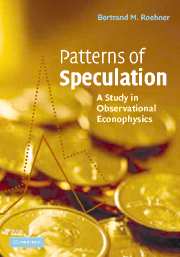Book contents
8 - DYNAMICS OF SPECULATIVE PEAKS: THEORETICAL FRAMEWORK
Published online by Cambridge University Press: 02 December 2009
Summary
Between 1938 and mid 1943 the price of nineteenth-century French stamps was on average multiplied by a factor three. In a previous chapter we interpreted that movement as a hedge against inflation. Such an interpretation is indeed confirmed by the fact that other inflationary periods were also marked by substantial peaks for stamp prices. Yet, if inflation can with good reason be considered as a triggering factor, the evidence suggests that price peaks have their own dynamics: once a speculative movement has been started it develops on its own momentum and ends when that momentum is exhausted. This is precisely what happened in 1943. Between 1939 and 1943 the average annual inflation rate in France was 18 percent; in combination with one or several other factors, which we do not yet understand, that inflation activated the speculation. The conclusion that the movement had its own dynamics is obvious from the fact that the turning point occurred in mid 1943, in spite of the fact that the inflation rate was higher in 1943 than in any previous year. After the downturn stamp prices continued to fall in spite of the fact that during the five following years the average annual inflation rate was as high as 46 percent. Somehow the momentum of the bubble was exhausted and even a huge inflation rate was unable to trigger another bubble. The same kind of phenomenon occurred for the gold and silver bubble in January 1980: the bubble was triggered by double-digit inflation rates, but it burst in spite of the fact that in 1980 the inflation rate in the United States reached the record level of 14 percent (the highest figure since 1974).
- Type
- Chapter
- Information
- Patterns of SpeculationA Study in Observational Econophysics, pp. 177 - 197Publisher: Cambridge University PressPrint publication year: 2002



